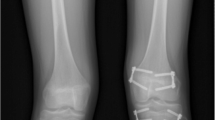Summary
Epiphyseal stapling to arrest growth in the longer limb in growing children has been used in 923 cases over 26 years in the management of leg length inequality. Five hundred and three were assessed at the end of growth. Seventy-one percent had 0.5 cm to 1 cm of shortening and 80% did not need an orthosis. Although other methods are available, this technique is particularly valuable in developing countries because it needs only basic surgical facilities and the financial cost is low.
Résumé
L'épiphysiodèse, dont le rôle est d'arrêter la croissance du membre trop long chez l'enfant en cours de croissance a été utilisée, avec la technique de Blount, sur 923 cas durant les 26 dernières années, afin de corriger les inégalités de longueur des membres inférieurs. Cinq cent trois patients ont été examinés à la fin de leur période de croissance, 71% avaient un raccourcissement compris entre 0,5 cm et 1 cm et 80% n'avaient pas besoin de porter une orthèse. Diverses opérations d'allongement sont aujourd'hui possibles, et même préférables, mais le niveau élevé des équipements, la durée du séjour à l'hôpital ainsi que la surveillance technique prolongée font que ces opérations ne sont pas à la portée de la majeure partie des enfants des milieux ruraux dans les pays en voie de développement. Notre longue expérience, menée sur un nombre important d'enfants traités avec des moyens chirurgicaux réduits et un coût peu élevé, montre que cette technique peut être utilisée dans les pays non industrialisés et aussi, dans certains cas choisis, dans les pays de technologie avancée.
Similar content being viewed by others
References
Acton N (1980) Childhood disability: its prevention and rehabilitation. Report of Rehabilitation International to the Executive body of UNICEF. UNICEF, New York E/ICEF1/22: 1410
Blount WP, Clark GR (1949) Control of bone growth by epiphysial stapling. Preliminary report. J Bone Joint Surg [Am] 31: 464
Blount WP (1971) A mature look at epiphysial stapling clin orthop 77: 158
Cameron BM (1975) A technique of femoral-shaft shortening. A preliminary report. J Bone Joint Surg [Am] 39: 1309
Canadell J, de Pablos J (1985) Breaking boney bridges by physeal distraction. A new approach. Int Orthop 9: 223–229
Capenter EB, Datton JB Jr (1963) Critical evaluation at a method of epiphyseal stimulation. J Bone Joint Surg [Am] 45: 642
Coleman SS (1978) Lower limb length discrepancy. In: WW Lovell, RB Winter (eds), Pediatric orthopaedics, vol 2. Lippincott, Philadelphia, p 805
Czitrom AA, Salter RB, Willias RB (1981) Fractures involving the distal epiphysial plate of the femur. Int Orthop 4: 269–277
Dutta Banik ND (1975) Study of longitudinal growth of children in a mixed urban and rural population in India. Report from the Indian Council of Medical Research, New Dehli
Eyre-Brook AL (1986) An appropriate approach to orthopaedics in developing countries. Int Orthop 10: 5–10
Green WT, Anderson M (1957) Epiphysial arrest for the correction of discrepancies in length of lower extremities. J Bone Joint Surg [Am] 39: 853
Green WT, Anderson M (1960) Skeletal age and the control of bone growth. American Academy of Orthopaedic Surgeons Instructional course lectures, vol XVII. Mosby, St Louis, p 199
Green WT, Wyatt GM, Anderson M (1948) Orthoroentgenography as a method of measuring the bones of the lower extremity. J Bone Joint Surg [Am] 28: 60
Jameel A, Narayan Singh V (1987) Potential impact of Advanced Trama Life Support (ATLS) Programe in a Third World country. Int Surg 72: 179
Katju MN (1965) Management of deformities of lower limbs in poliomyelitis. Paper Conf on Rehabilitation Orth Section of ASI and Ind Sec Rehab Handicapped, New Delhi AIIMS
Von Langenbeck B (1989) Cited Campbell's operative orthopaedics, vol 2. Igaku Shoin Ltd, Tokyo 1965
Lombardo SJ, Harvey JP (1977) Fractures of the distal femoral epiphysis. J Bone Joint Surg [AM] 59: 742–751
Rang M (1974) Children's fractures. Lippincott, Toronto
Please C (1952) Local stimulation of growth of long bones, a preliminary report. J Bone Joint Surg [Am] 34: 1
Phemister DB (1933) Operative arrestment of longitudinal growth of bones in the treatment of deformities. J Bone Joint Surg 5: 1–15
Sengupta A (1969) Unusual displacement of lower femoral epiphysis. Ind Med Forum 23: 531
Sengupta A (1969) Supracondylar Subperiosteal distraction in correction of knee deformities. Paper Ann Cont of Ind Orth Assn, Patna
Sengupta A (1987) Management of congenital talipes equinovarus in developing countries. Int Orthop 11: 183–187
Sengupta A (1981) Problems of disability in India. Editorial J Ind Med Ass 76: 194–197
Sengupta A, Gupta P (1987) Priorities in management procedures in paediatric orthopaedics. 2nd Int Conf Surgery in Tropics, Bombay
Sengupta A, Gupta P (1989) Management of limb length problems with epiphysial stapling in developing countries. Paper presented at the zonal conference of the International College of Surgeons, Indian Section
Sethi PK (1990) Designing aids for physically handicapped in developing countries. Ind J Phys Med Rehab 3: 1–10
Stephens DC, Louis E, Louis DC (1974) Traumatic Seperation of distal femoral epiphysial cartilage plate. J Bone Joint Surg [Am] 56: 1383–1390
Wilk LH, Badgley CE (1963) Hypertension, another complication of leg leng the ring procedure. Report of a case. J Bone Joint Surg [Am] 45: 1263
Yosipouith ZH, Palti Y (1967) Alteration of blood pressure during leg lenthening. A clinical and experimental investigation. J Bone Joint Surg [Am] 49: 1352
Author information
Authors and Affiliations
Rights and permissions
About this article
Cite this article
Sengupta, A., Gupta, P. Epiphyseal stapling for leg equalisation in developing countries. International Orthopaedics 17, 37–42 (1993). https://doi.org/10.1007/BF00195222
Issue Date:
DOI: https://doi.org/10.1007/BF00195222




